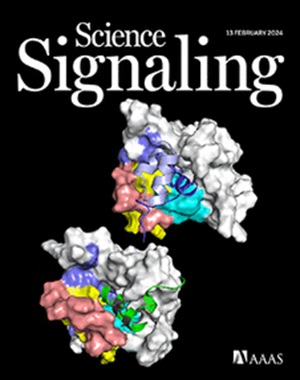Proteomic analyses identify targets, pathways, and cellular consequences of oncogenic KRAS signaling
IF 6.6
1区 生物学
Q1 BIOCHEMISTRY & MOLECULAR BIOLOGY
引用次数: 0
Abstract
Mutations that activate the small GTPase KRAS are a frequent genetic alteration in cancer, and drug discovery efforts have led to inhibitors that block KRAS activity. We sought to better understand oncogenic KRAS signaling and the cytostatic effects of drugs that target this system. We performed proteomic analyses to investigate changes in protein abundance and posttranslational modifications in inhibitor-treated human KRAS-mutant pancreatic (KRAS G12C and G12D) and lung cancer (KRAS G12C) cells. The inhibitors used target these mutant forms of KRAS, the downstream effectors MEK and ERK, and the upstream regulators SHP2 and SOS1. Comparisons of phosphoproteomes between cell lines revealed a core KRAS signaling signature and cell line–specific signaling networks. In all cell lines, phosphoproteomes were dominated by different degrees of autonomous, oncogenic KRAS activity. Comparison of phosphoproteomes after short and long drug exposures revealed the temporal dynamics of KRAS-MEK-ERK axis inhibition that resulted in cell cycle exit. This transition to a quiescent state occurred in the absence of substantial proteome remodeling but included broad changes in protein phosphorylation and ubiquitylation. The collective data reveal insights into oncogenic KRAS signaling, place many additional proteins into this functional context, and implicate cell cycle exit as a mechanism by which cells evade death upon KRAS signaling inhibition.
蛋白质组学分析确定目标,途径和肿瘤KRAS信号传导的细胞后果
激活小GTPase KRAS的突变是癌症中常见的遗传改变,药物发现努力已经导致了阻断KRAS活性的抑制剂。我们试图更好地了解致癌KRAS信号和靶向该系统的药物的细胞抑制作用。我们进行了蛋白质组学分析,以研究抑制剂处理的人类KRAS突变型胰腺(KRAS G12C和G12D)和肺癌(KRAS G12C)细胞中蛋白质丰度和翻译后修饰的变化。所使用的抑制剂针对这些突变形式的KRAS,下游效应物MEK和ERK,以及上游调节物SHP2和SOS1。细胞系之间磷酸化蛋白质组的比较揭示了核心KRAS信号信号特征和细胞系特异性信号网络。在所有细胞系中,磷酸化蛋白质组由不同程度的自主致癌KRAS活性主导。比较短时间和长时间药物暴露后的磷酸化蛋白质组,揭示了KRAS-MEK-ERK轴抑制导致细胞周期退出的时间动态。这种向静止状态的转变发生在没有实质性蛋白质组重塑的情况下,但包括蛋白质磷酸化和泛素化的广泛变化。这些集体数据揭示了对致癌KRAS信号传导的见解,将许多其他蛋白质置于这种功能背景下,并暗示细胞周期退出是细胞在KRAS信号传导抑制下逃避死亡的机制。
本文章由计算机程序翻译,如有差异,请以英文原文为准。
求助全文
约1分钟内获得全文
求助全文
来源期刊

Science Signaling
BIOCHEMISTRY & MOLECULAR BIOLOGY-CELL BIOLOGY
CiteScore
9.50
自引率
0.00%
发文量
148
审稿时长
3-8 weeks
期刊介绍:
"Science Signaling" is a reputable, peer-reviewed journal dedicated to the exploration of cell communication mechanisms, offering a comprehensive view of the intricate processes that govern cellular regulation. This journal, published weekly online by the American Association for the Advancement of Science (AAAS), is a go-to resource for the latest research in cell signaling and its various facets.
The journal's scope encompasses a broad range of topics, including the study of signaling networks, synthetic biology, systems biology, and the application of these findings in drug discovery. It also delves into the computational and modeling aspects of regulatory pathways, providing insights into how cells communicate and respond to their environment.
In addition to publishing full-length articles that report on groundbreaking research, "Science Signaling" also features reviews that synthesize current knowledge in the field, focus articles that highlight specific areas of interest, and editor-written highlights that draw attention to particularly significant studies. This mix of content ensures that the journal serves as a valuable resource for both researchers and professionals looking to stay abreast of the latest advancements in cell communication science.
 求助内容:
求助内容: 应助结果提醒方式:
应助结果提醒方式:


